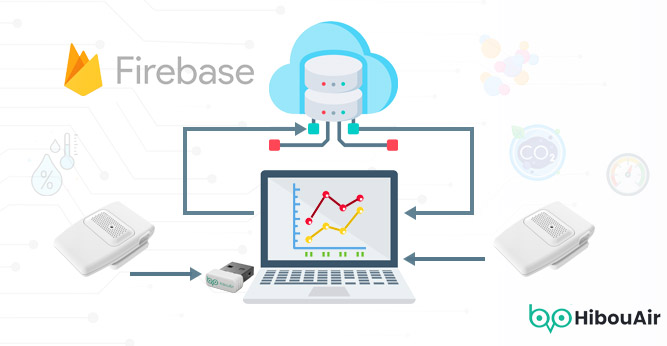How to Save Data in the Cloud if you have HibouAir Desktop Solution
In today’s fast-paced world, monitoring indoor air quality is not only essential for health but also a key aspect of overall well-being. HibouAir’s innovative desktop solution takes this a step further by not only providing real-time air quality data but also offering a seamless way to store this information securely in the cloud.
In this guide, we’ll walk you through the simple process of integrating Google Firebase with your HibouAir desktop solution.
Cloud Connectivity for Remote Access:
To complete the process of enabling cloud connectivity for your HibouAir desktop solution, follow these additional steps to set up Google Firebase integration:
- Go to the Google Firebase console at https://console.firebase.google.com.
- Log in to your Google account.
- Click on “Add a new project” and fill out the required information to create the project.

- Once the project is created, you will be redirected to the newly created project dashboard.
- Select “Web” from the “Get started by adding Firebase to your app” section.

- Register your app by filling out the form on the next screen.
- On the second step, you will be presented with details of your Firebase app API. Note down this API information as you will use it in the HibouAir app to send air quality data to the cloud.

- After clicking on the console, you’ll be redirected back to the Firebase app dashboard. Now, follow these steps to create a real-time database:
- Select “All products” from the left menu.

- Choose “Realtime Database.”

- Click on “Create Database” on the next screen, selecting your zone. Choose “Start in lock mode” as default and click “Enable.” (Note: You will update this setting later.)
- After enabling, you’ll be redirected to the Realtime Database screen. Copy the database URL, as it will be needed for the HibouAir script to store data into the database.
- Select “Rules” from the top tab bar and update the rules to be true. Once done, click on “Publish.”

- With these settings in place, everything is set up. Update the HibouAir script with the API and database information you noted earlier. This will allow the script to collect and store air quality data from HibouAir to the cloud seamlessly.
Script Integration for Data Visualization and export
Ensure you have a HibouAir device plugged in and the Smart BLE USB dongle is connected to your computer. Visit https://hibouair.com/cloud-storage and follow the instructions to fill out the required information. This step initiates the process of sending air quality data to the cloud.
Now, the HibouAir script is configured to send data to the cloud on your own Firebase account. This user-centric approach ensures that you have complete control over your data. The script facilitates easy access to your air quality data through chart visualizations directly within the application. These interactive charts provide a comprehensive overview, aiding in better understanding and comparison of air quality attributes over time. Additionally, the script enables users by offering the option to export data in CSV format. This feature proves invaluable for those seeking more in-depth analysis.

